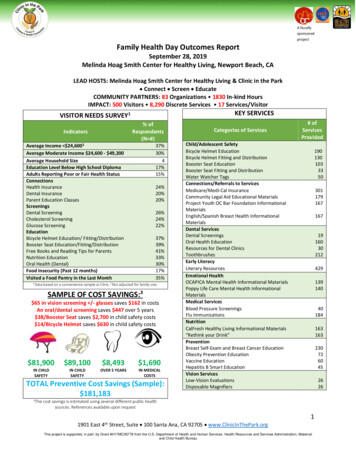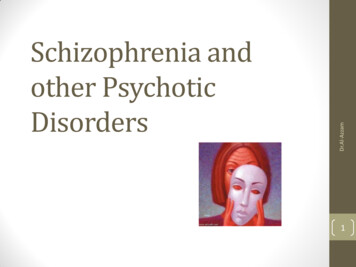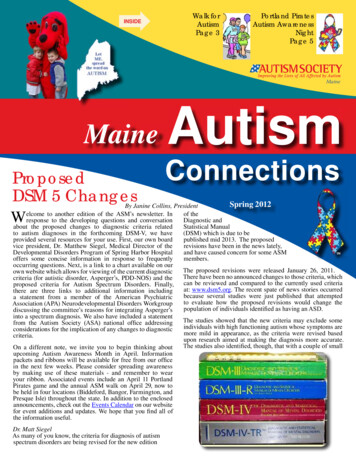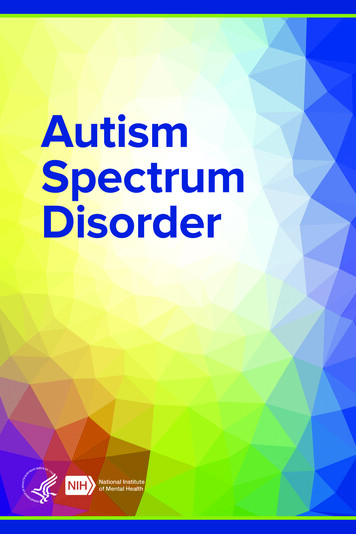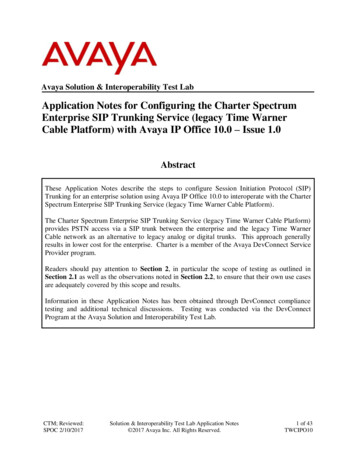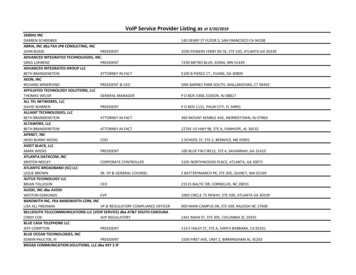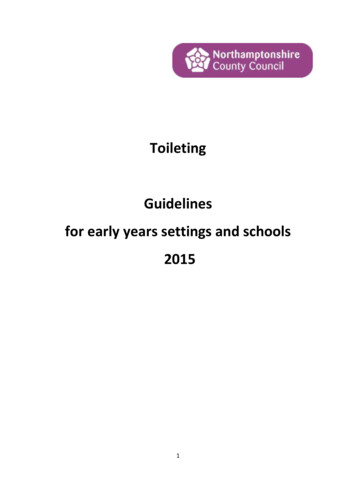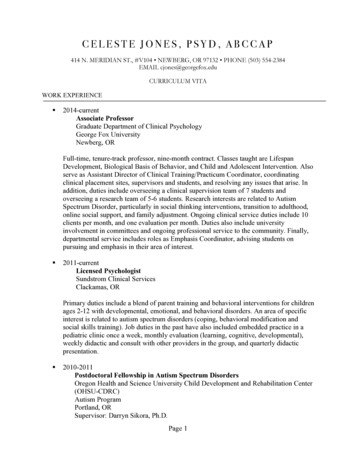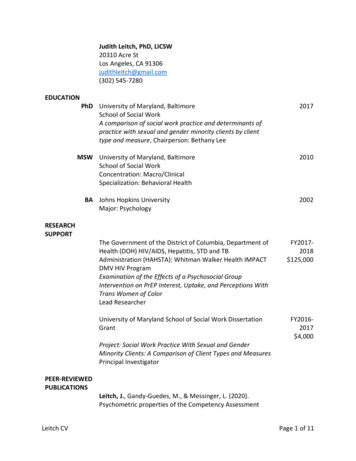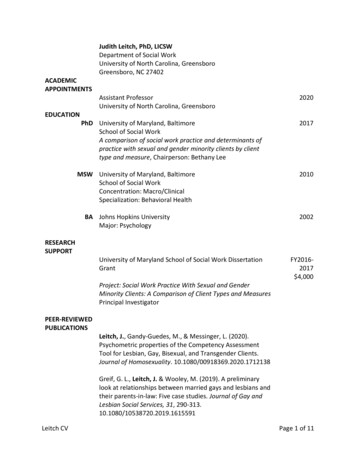
Transcription
Autism Spectrum Disorders:Guide to Evidence-basedInterventionsA 2012 CONSENSUS PUBLICATIONSponsored by the Thompson Foundation for Autism; the Division ofDevelopmental Disabilities, Missouri Department of Mental Health;the Office of Special Education, Missouri Department of Elementaryand Secondary Education; and Mercy Children’s Hospital – St. Louisand Springfield
This publication was developed as a result of a partnership between the Thompson Foundation forAutism, the Office of Special Education of the Missouri Department of Elementary and SecondaryEducation, the Division of Developmental Disabilities of the Missouri Department of Mental Health,Mercy Children’s Hospital – St. Louis and Springfield, and members of the Missouri Autism GuidelinesInitiative. All rights under federal copyright laws are held by the Division of Developmental Disabilitiesexcept for those previously published materials included in this document.All parts of this publication, except for previously published materials credited to the authors and/or publishers, may be reproduced in any form of printed or visual medium. Any reproduction of thispublication may not be sold for profit or reproduction costs without the exclusive permission ofthe Division of Developmental Disabilities. Any reproduction of this publication, in whole or in part,shall acknowledge, in writing, the Thompson Foundation for Autism, the Division of DevelopmentalDisabilities, the Office of Special Education, and Mercy Children’s Hospital – St. Louis and Springfield.This publication is available at no charge at www.autismguidelines.dmh.mo.gov.Excerpts from previously published articles included in this document are reprinted with permissionfrom the author and/or publishers and are for personal use only. They may not be reproduced withoutthe express written consent of the author and/or publisher.Funding for the printing and dissemination of this Guide was provided in whole by the MissouriFoundation for Health. The Missouri Foundation for Health is a philanthropic organization whose visionis to improve the health of the people in the communities it serves.MO Division of Developmental DisabilitiesDepartment of Mental Health
Autism Spectrum Disorders:Guide to Evidence-based InterventionsA 2012 Consensus Publicationg u i d e to ev i d e n c e - ba s e d i n t e rv e n t i o n s3
Missouri Autism Guidelines InitiativeOversight CommitteeJoan E. Armstrong, MS, LPCJoel D. Bregman, MDJanet E. Farmer, PhD, ABPPDawn Huber, PhDMichele Kilo, MDJohn F. Mantovani, MDVicki McCarrell, MAKim Goodrich Ratcliffe, EdDAdvisory CommitteeJanice AmleshiSally Becker, OTR/LG. Elaine Beussink, MA, CCC-SLPRebecca Blackwell, MA, BCBA, LBACynthia Bliem-Sharp, MSAmy Buie, MEd, BCBAJohn N. Constantino, MDMarilyn CoxJulie A. Donnelly, PhDBeth Emmendorfer, EdDLisa Fowler-Koeppe, OTR/LJenny Frisbee, MA, BCBA, LBAJennifer GrayJohn M. Guercio, PhD, BCBA-D, CBIST, LBALauree HeadConnie Hébert, MS EdSusan Henderson, MSPatricia Kopetz, EdDRonald Kruse, EdDJulia LePage, MS, BCBALori Lewis, MS, CCC-SLP/MACMelinda Long, MS, CCC-SLPJeanne Marshall, MEd, MA, BCBA, LBABrenda Martien, MS, CCC-SLP/MACStacey Martin, MA, MACRolanda Maxim, MDMicah Mazurek, PhDDonald McCary, MS, BCBAVicky Mieseler, MSVictoria Moore, PsyDKaye Otten, PhDColin M. Peeler, PhD, BCBA-D, LBAShula Portnoy, MDClaudia Preuschoff, MD, FAAPJena Randolph, PhDGregory R. Robinson, PhDRobin RussellDuru Sakhrani, MDKristin A. Sohl, MD, FAAPTodd Streff, MS, BCBAKeenan Stump, MS, SLPJoAnn Youngblood, PhDLaine Young-Walker, MDS ta f fKaren Bodenhorn, MPH, Project DirectorDawn Huber, PhD, Senior Project Staff WriterLee Falk, BJ, Communications DirectorRon Huff, PhD, Senior Project Staffg u i d e to ev i d e n c e - ba s e d i n t e rv e n t i o n si
Table of ContentsAcknowledgments. . . ivChapter 1: IntroductionIntroduction.1The Need for This Guide. 3Overview of Evidence-based Practice . 5Evidence-based Practice as a Framework for ASD Intervention. 6Systematic Reviews Provide the Best Available Research to SupportEvidence-based Practice.7Research Reviews that Inform This Guide. 8Core Values of the Missouri Autism Guidelines Initiative. 9Family-centered Care. 9Early Intervention and Ongoing Support. 10Informed Professional Judgment. 10The Interdisciplinary Team. 10Community Collaboration. 10How to Use This Guide. 12Chapter 2: Evidence-based InterventionIntroduction. 13Importance of Community Collaboration.15Evidence-based Practice Provides a Framework forEffective ASD Intervention. 16Best Available Research.17Individual Characteristics.17Professional Expertise. 18The Intervention Process. 19Step One. Conduct Assessment. 19Essential Components of Assessment. 19Step Two. Develop Intervention Plan.22Component One. Identify Goals.22Component Two. Select Interventions.24Component Three. Determine Progress Monitoring Procedures.24Step Three. Monitor Progress.25Families and the Intervention Process.26The Intervention Process Across Service Delivery Systems.27Special Considerations for Service Delivery Systems.30Special Considerations for Healthcare .30Healthcare Case Example.35Special Considerations for Other Service Systems.36Other Service Systems Case Example. 37Special Considerations in Public Education .39Case Examples Illustrating the Intervention Processin Public Education Systems.45Transitions Between Delivery Systems.50Medical and Healthcare Issues.50Educational Transitions.51Transition from School to Adult Services.52Transition Case Example.53iiautism spectrum disor ders
Chapter 3: Research FindingsIntroduction .55Importance of Systematic Reviews. 57Overview: Six Systematic Reviews 2009-2011.58Cross-cutting Implications.62Challenges of Drawing Conclusions Across Reports.62Methodology to Identify Effective ASD Interventions .62Effective ASD Interventions .63Goal Areas Targeted by Effective ASD Interventions.71Ineffective ASD Interventions.73Harmful ASD Interventions.73Other ASD Interventions .74Need for Additional Research.74Looking Ahead Toward New Research. 75Description of Effective ASD Interventions. 75Chapter 4: Summaries of Research ReviewsIntroduction .115Review Summaries. 116National Professional Development Center (NPDC).117Centers for Medicare and Medicaid Services (CMS).123National Standards Project (NSP).147Agency for Healthcare Research and Quality (AHRQ).163Stanford Autism Research Team (StART) .171Comprehensive Treatment Models (CTM).176Bibliography. 181AppendicesAppendix A: Missouri Autism Guidelines Initiative .189Appendix B: Glossary of Terms and Acronyms.192Appendix C: Effective ASD Interventions by Domain.204Appendix D: Resources for Parents and Professionals.214Appendix E: Sample Intervention Plan . 220Index of Intervention Names. 223case examplesHealthcare Case Example.35Other Service Systems Case Example.37Case Examples Illustrating the Intervention Processin Public Education Systems.45Transition Case Example.53g u i d e to ev i d e n c e - ba s e d i n t e rv e n t i o n siii
AcknowledgmentsAutism Spectrum Disorders: Guide to Evidence-based Interventions is the result of apublic-private partnership between the Thompson Foundation for Autism; the Division ofDevelopmental Disabilities, Missouri Department of Mental Health; the Office of SpecialEducation, Missouri Department of Elementary and Secondary Education; and MercyChildren’s Hospital – St. Louis and Springfield.Working together as the Missouri Autism Guidelines Initiative, we are proud to haveinitiated the collaborative process between parents and professionals which has resultedin our second publication, the companion document to our 2010 publication, AutismSpectrum Disorders: Missouri Best Practice Guidelines for Screening, Diagnosis, andAssessment.Together we thank and gratefully acknowledge:nnnIndividuals and families who live with autism spectrum disorders (ASDs) and whoare dedicated to identifying and securing high-quality, evidence-based, effectiveinterventions in their communities. We are grateful for the thoughtful input of theparents who participated in the development of this document. As with the Initiative’sfirst publication, the insights of parents have made this book better and more accessibleto families.The community of professionals, including healthcare professionals, educators, and otherservice providers, who partner with families and each other in delivering quality ASDcare. The intervention process is enriched through their professional experience andtheir knowledge of each family they serve.The ASD researchers who produced the six systematic research reports on which thisdocument is based, especially those who led symposia for the Missouri Autism GuidelinesInitiative to inform our thinking. These national experts challenged us to think morebroadly and to expand our work to include the complex cross-cutting summaries thatfamilies and professionals most need.– Lynne C. Huffman, MD, Associate Professor, Pediatrics, Stanford University School ofMedicine and leader of the Stanford Autism Research Team (StART), Palo Alto, CA– Samuel L. Odom, PhD, Director of Frank Porter Graham Child Development Institute,University of North Carolina at Chapel Hill and Principal Investigator of the NationalProfessional Development Center on Autism Spectrum Disorders– Hanna C. Rue, PhD, BCBA-D, Director of Applied Research and Evidence-based Practiceat the National Autism Center, Randolph, MA– Jeremy Veenstra-VanderWeele, MD, Assistant Professor of Psychiatry, Pediatrics, andPharmacology, Vanderbilt University, Nashville, TNnivautism spectrum disor dersMembers of the Missouri Autism Guidelines Initiative, under the leadership of theOversight Committee. These Missouri parents and professionals worked together formore than a year through a collaborative process focused on understanding the scopeof the six systematic reviews and formulating the overall content and core values ofthe Guide.
nnThe professional staff who worked to develop the project’s consensus process, draftedthe document, and built understanding of the research: Karen Bodenhorn, MPH; DawnHuber, PhD; Ron Huff, PhD; and Agnes DeRaad, MA. Once again, their contributions tothis project exceeded all expectations.The Missouri Foundation for Health, which generously supported the communication,publication, and dissemination of this Guide under the guidance of Lee Falk andLaura Burns Gericke.A special note of thanks goes to the directors of the Thompson Foundation for Autism, ledby Bill and Nancy Thompson. Their vision, time, talents, and financial support are creatingpartnerships and collaborations that are truly improving the lives of those with ASDs andtheir families in Missouri and beyond.Bernard SimonsRon AshworthGay TompkinsStephen BarrDivision of DevelopmentalDisabilities, MissouriDepartment of MentalHealthMercy Children’s Hospital –St. Louis and Springfieldand Thompson Foundationfor AutismThompson Foundationfor AutismOffice of Special Education,Missouri Department ofElementary and SecondaryEducationg u i d e to ev i d e n c e - ba s e d i n t e rv e n t i o n sv
c h ap te r 1Introductionchapter 1g u i d e to ev i d e n c e - ba s e d i n t e rv e n t i o n s1
IntroductionThis Guide, produced by the Missouri Autism Guidelines Initiative, describes evidencebased interventions for individuals with autism spectrum disorders (ASDs) based onsix recent nationally recognized systematic research reviews. The document providesinformation and tools to support individuals with ASDs and their families and to assisthealthcare professionals, educators, and other community-based service providers inmaking informed decisions about selection, implementation, and monitoring of ASDinterventions.Throughout the Guide several key concepts emerge regarding evidence-based interventions.nEmphasis on evidence-based practice. Evidence-based practice has become the current bench-mark for professionals in medicine, psychology, education, and other healthcare fields.Evidence-based practice includes a combination of the best available scientific evidence,professional expertise, and understanding of client characteristics.nScientific research informs evidence-based practice. Review of evidence from scientific researchis the foundation of evidence-based practice and decision making regarding interventionsto consider and those to avoid. Current research evidence provides important informationabout effective ASD interventions, but more research is needed. (For example, researchon interventions for adults with ASDs is extremely limited.) Lack of the highest qualityresearch data about an intervention does not in itself preclude consideration of thatintervention.nEvidence-based practice is informed by professional expertise. Although scientific researchis critical to evidence-based practice, professional expertise and judgment guide theinterpretation and application of available research evidence.nEvidence-based practice includes consideration of individual characteristics. Intervention decisionsfor individuals with ASDs are not based solely on scientific evidence and professionalexpertise, but are made in the context of the strengths, concerns, values, and preferencesof the person with an ASD and his or her support network. This network includes thefamily, the professional team, and available community resources.n2autism spectrum disor dersImportance of systematic research reviews. The rapid growth of the scientific literature onASDs makes it challenging for families and practitioners to stay up-to-date with researchfindings. Systematic reviews play an important role in summarizing and synthesizing theknowledge base on ASD interventions. To provide individuals with ASDs, their families,and professionals with the most current evidence to guide intervention planning andimplementation, this project presents findings from six nationally recognized systematicresearch reviews on evidence-based ASD interventions.
c h a p te r 1nEffective ASD interventions can lead to improved outcomes. The systematic reviews presentedin this Guide describe effective evidence-based interventions that have produced positiveoutcomes for individuals with ASDs. Outcomes are maximized when interventions arematched to individual characteristics and begun as early as possible.The Need for This GuideAutism spectrum disorders (ASDs) now affect approximately 1 in 88 American children(CDC, 2012). ASDs have lifelong effects on individual functioning in areas such as learning,relationships, and independence in daily life. The initial publication of the MissouriAutism Guidelines Initiative, Autism Spectrum Disorders: Missouri Best Practice Guidelinesfor Screening, Diagnosis, and Assessment (www.autismguidelines.dmh.mo.gov), presentscurrent best practice in screening, diagnostic evaluation, and assessment for interventionplanning for individuals with ASDs. This Guide is a companion publication that beginswhere the initial document left off—with the importance of comprehensive assessment forintervention planning—and describes the next steps in the intervention process includingdevelopment and implementation of an intervention plan.Pathway to Improved OutcomesFigure 1.1ScreeningDiagnosisAssessmentfor InterventionPlanningDevelopment andImplementation ofIntervention PlanImproved Outcomesn Level of Independencen Health and Wellbeingn Quality of LifeFigure 1.1 attempts to capture the dynamic nature of the process from screening to improved outcomes.Although the steps are depicted as occurring one after the other, the sequence of the steps variesbased on individual needs and what providers are able to accomplish with available skills and resources.Development and implementation of an intervention plan is depicted as occurring after diagnosis, butit may begin earlier in the process. For example, when screening results are positive, children may beimmediately referred for certain intervention services; in these cases, assessment, selection, and implementation of initial interventions may occur while plans are being made to conduct the diagnosticevaluation. Information from initial assessment and intervention can then inform the diagnosticprocess and future intervention decisions.g u i d e to ev i d e n c e - ba s e d i n t e rv e n t i o n s3
Assisting persons with ASDs and their families to achieve positive outcomes is a continuousand ongoing process. Interventions for ASDs vary in scope, focus, purpose, intensity, duration,and methodology. They focus on improving social interaction and communication,addressing challenging behaviors, increasing educational engagement and achievement,treating commonly associated difficulties (e.g., anxiety), promoting independence, andimproving quality of life. Intervention goals vary for different individuals and most individuals with ASDs receive a combination of interventions. Access to effective interventionis critical. Individuals with ASDs, their families, and professionals who care for personswith ASDs all want to use interventions that work. Over the past 5 years, several nationallyrecognized research groups have used systematic reviews to describe the available evidenceon the effectiveness, benefits, and harms of different intervention options for individualswith ASDs. The methods used in these reviews differ and, as a result, the reviews differto some extent in their findings. Yet an important message consistently emerges acrossall of the reviews: Although this is an evolving field, research evidence on the effectiveness ofinterventions for ASDs has shown promise. There are effective interventions that produce positiveoutcomes for persons with ASDs.To make the best decisions about intervention options for persons with ASDs, individualswith ASDs and their families, healthcare professionals, educators, and other service providersneed up-to-date information about intervention choices. The six systematic researchreviews summarized as a key part of this publication fill a need for this type of information(see Chapter Four). In addition, a list of 39 effective interventions has been developed byconsensus of the Missouri Autism Guidelines Initiative to describe interventions rankedat the top level of research support by one or more of the systematic reviews summarizedin this Guide. This list of interventions provides a synthesis of findings across reviews (seeChapter Three). It is not the intention of this document to recommend what interventionsshould or should not be used for a specific individual with an ASD. Instead, the documentdescribes an evidence-based approach to intervention selection as part of an overallprocess that includes comprehensive assessment for intervention planning, developmentand implementation of an intervention plan, and progress monitoring.4autism spectrum disor ders
c h a p te r 1Overview of Evidence-based PracticeEvidence-based practice originated in the medical field, where thousands of carefullycontrolled research studies have been conducted. Dr. David Sackett, a pioneer in evidencebased practice, and his colleagues defined evidence-based medicine as “the conscientious,explicit, and judicious use of current best evidence in making decisions about the care ofindividual patients. The practice of evidence-based medicine means integrating individualclinical expertise with the best available external clinical evidence from systematicresearch” (Sackett et al., 1996, 71-72). Similarly, the Institute of Medicine has definedevidence-based practice as “the integration of best-researched evidence and clinicalexpertise with patient values” (National Research Council, 2001).Disciplines such as psychology and education have embraced the evidence-based practicemovement as a nationwide effort to build quality and accountability. The AmericanPsychological Association has defined evidence-based practice as “the integration of thebest available research with clinical expertise in the context of patient characteristics,culture, and preferences” (APA, 2001).Definitions incorporated into state and federal laws and regulations also guide practice.For example, the regulations for the federal law which ensures that all children withdisabilities have access to a free and appropriate public education (FAPE), the Individualswith Disabilities Education Act (IDEA), requires that educational strategies be based on“scientifically based research.” The regulations define scientifically based research “asresearch that involves the application of rigorous, systematic, and objective proceduresto obtain reliable and valid knowledge relevant to education activities and programs”[20 U.S.C. 1411 (e) (2) (C) (xi)]. Similarly, the National Center on Response to Intervention, anational technical assistance center for schools and school districts, defines evidence-basedinterventions as those “for which data from scientific, rigorous research designs havedemonstrated the efficacy of the intervention” (National Center on Response to Intervention,2010, p. 6).Although there is no universal definition of evidence-based practice, definitions fromdiverse areas of professional practice share the following core theme: Evidence-basedpractice requires careful assessment of current research with the goal of identifying interventions that have demonstrated effectiveness.nnnThe quality of research studies must be assessed, as this varies from study to study.More than one study by more than one research group must show the same outcome toensure confidence in the results.Evidence must be considered in the context of professional expertise and individualcharacteristics.g u i d e to ev i d e n c e - ba s e d i n t e rv e n t i o n s5
Evidence-based Practice as a Framework for ASD InterventionIndividuals with ASDs, their families, and providers all want to select interventions thatresult in improved outcomes. This Guide presents evidence-based practice as a frameworkfor decision making that results in selection and implementation of interventions thatare most likely to be effective in meeting the goals of a specific individual with an ASD.Evidence-based practice includes consideration of the best available research evidencein the context of individual characteristics and professional expertise (see Figure 1.2).Evidence-based practiceFigure idualCharacteristicsBestAvailableResearchChapter Two describes an evidence-based approach to intervention selection as part ofa three-step intervention process that includes assessment for intervention planning,development and implementation of an intervention plan, and progress monitoring.Following assessment to identify the individual’s strengths and needs, families andproviders work together to review interventions with a high level of research support thatfit with individual intervention goals and other individual characteristics. Interventionselection includes consideration of individual and family values and preferences, as wellas available family and community resources. Professional expertise plays a critical rolein interpreting and applying research findings during intervention selection and informsdecision making throughout the intervention process.6autism spectrum disor ders
c h a p te r 1Systematic Reviews Provide the Best Available Research toSupport Evidence-based PracticeEvidence-based practice is not uniformly applied in all areas of professional practice orby all professionals in any given discipline. Some professionals contact trusted colleagueswho are familiar with the research literature for suggestions regarding effective interventions. Others use interventions with which they have extensive experience in improvingoutcomes. Two other approaches to evidence-based practice have been described (Dijkers,2008). In the first approach, a professional who is faced with a decision regarding whichintervention to use searches the literature, reviews abstracts to identify relevant studies,retrieves copies of these studies, synthesizes their findings, and integrates this informationwith his or her professional experience and the characteristics of the person with an ASD toselect the intervention. In the second approach, professionals turn to systematic revi
department of mental Health Ron Ashworth mercy children’s Hospital – st. Louis and springfield and thompson Foundation for autism Gay Tompkins thompson Foundation for autism Stephen Barr office of special education,
